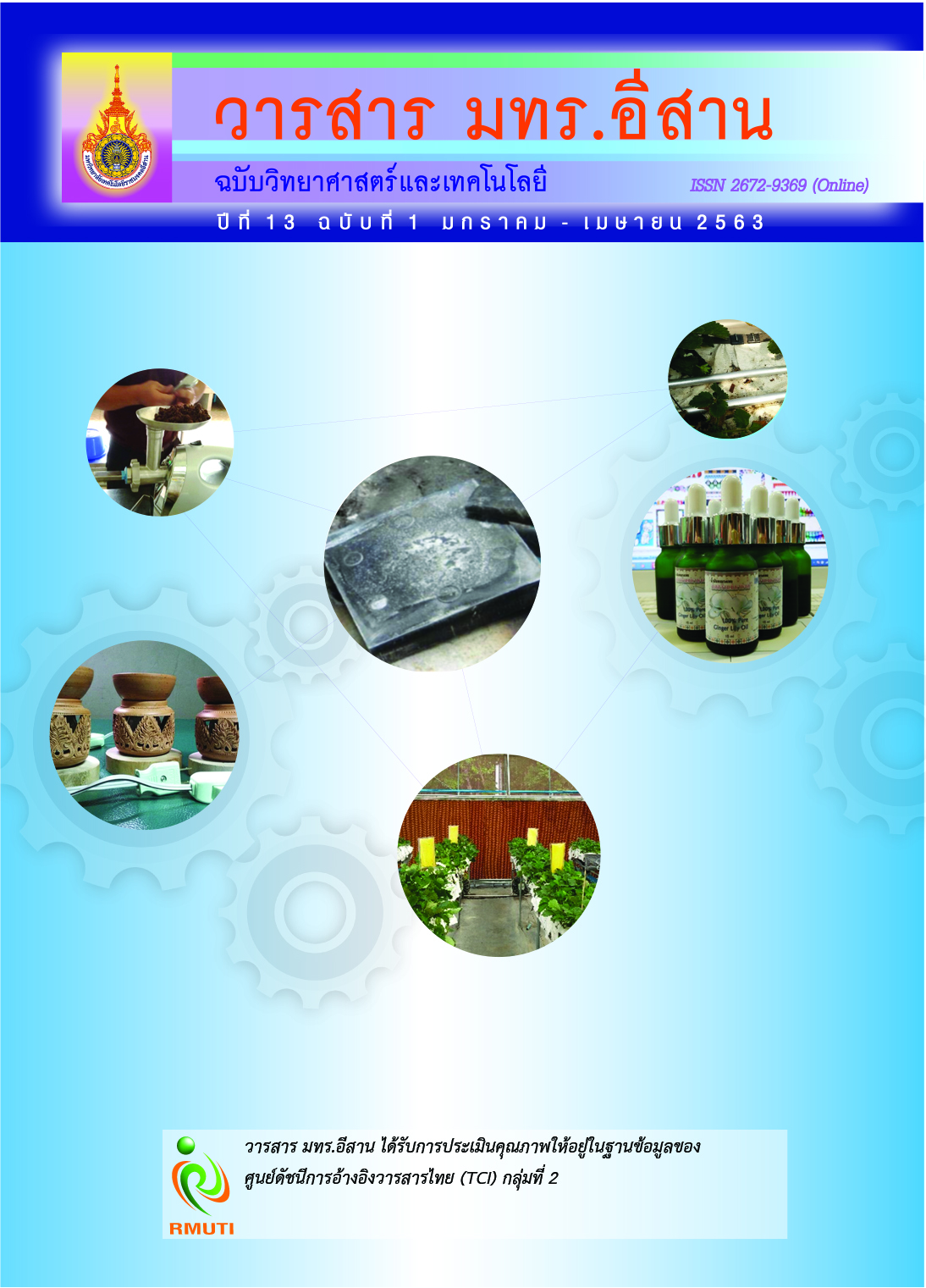การเพิ่มศักยภาพการทำความเย็นบริเวณทรงพุ่มสตรอว์เบอร์รี่โดยการทำความเย็นแบบระเหยร่วมกับการบังคับอากาศใต้รางปลูกและท่อนํ้าเย็น
Main Article Content
บทคัดย่อ
งานวิจัยนี้มีวัตถุประสงค์ศึกษาการเพิ่มศักยภาพการทำความเย็นเพื่อรักษาอุณหภูมิทรงพุ่มของพืชในโรงเรือนสตรอว์เบอร์รี่ที่มีการใช้ระบบทำความเย็นแบบระเหยร่วมกับการบังคับทิศทางอากาศใต้รางปลูกและท่อน้ำเย็น โรงเรือนกว้าง 6 m ยาว 24 m สูง 4.8 m หลังคาคลุมด้วยพลาสติกโพลีเอทิลีนและผนังคลุมด้วยตาข่าย กันแมลง ผนังทิศเหนือติดแผ่นระเหยน้ำมีพื้นที่ 14.04 m2 ภายในโรงเรือนมีรางปลูกกว้าง 0.3 m ยาว 21 m และสูง 1 m ใต้รางปลูกติดพัดลมระบายอากาศขนาด 50 W และติดพลาสติกรอบรางปลูกและเว้นช่องเปิดกว้าง 0.10 m ท่อนํ้าเย็นทำจากอะลูมิเนียมเส้นผ่านศูนย์กลาง 1.27 cm ยาว 21 m จำนวน 1 กลับ ติดตั้งบนรางปลูกระหว่างทรงพุ่มสตรอว์เบอร์รี่ จากการศึกษาพบว่า การบังคับทิศทางอากาศสามารถ ลดอุณหภูมิอากาศบริเวณทรงพุ่มได้สูงสุด 5.5 oC เมื่อเทียบกับกรณีไม่มีการบังคับทิศทางอากาศ และพบว่าการใช้ท่อนํ้าเย็นเพื่อการทำความเย็นบริเวณทรงพุ่มนั้นไม่มีผล จากการศึกษาแบบจำลองทาง คณิตศาสตร์พบว่าการเลือกใช้พัดลมที่มีความเร็วอากาศที่มากขึ้นร่วมกับการเพิ่มความกว้างช่องเปิดของระบบบังคับทิศทางอากาศร่วมกันจะสามารถลดอุณหภูมิทรงพุ่มสตรอว์เบอร์รี่ได้ประมาณ 4 - 5 oC และมีค่าสัมประสิทธิ์สมรรถนะของระบบเพิ่มขึ้น 66.12 %
Article Details
เอกสารอ้างอิง
Laknizi, A., Mahdaoui, M., Ben Abdellah, A., Anoune, K., Bakhouya, M., and Ezbakhe, H. (2019). Performance Analysis and Optimal Parameters of a Direct Evaporative Pad Cooling System under the Climate Conditions of Morocco. Case Studies in Thermal Engineering. Vol. 13, pp. 100362. DOI: 10.1016/j.csite.2018.11.013
Xu, J., Li, Y., Wang, R. Z., Liu, W., and Zhou, P. (2015). Experimental Performance of Evaporative Cooling Pad Systems in Greenhouses in Humid Subtropical Climates. Applied Energy. Vol. 138, Issue C, pp. 291-301. DOI: 10.1016/j.apenergy.2014.10.061
Waewsak, J., Kaew-on, J., Kongruang, C., Katathirakol, S., and Nutongkaew, P. (2016). Increasing Productivity and Input Energy Relationship with Mushroom Yield and Economic Analysis of Evaporative and Mist Cooling Greenhouse together with Automatic Solar Ventilation Systems. Thaksin University. (in Thai)
Mehmet, A. D. and Hasan, H. S. (2015). Performance Analysis of a Greenhouse Fan-pad Cooling System: Gradients of Horizontal Temperature and Relative Humidity. Journal of Agricultural Sciences. Vol. 21, pp. 132-143
Romantchik, E., Rios, E., Sanchez, E., Lopez, I., and Sanchez, J. R. (2017). Determination of Energy to be Supplied by Photovoltaic Systems for Fan-pad Systems in Cooling Process of Greenhouses. Applied Thermal Engineering. Vol. 114, pp. 1161-1168. DOI: 10.1016/j.applthermaleng.2016.10.011
Hasan, O. Z., Atilgan, A., Buyuktas, K., and Alagoz, T. (2009). The Efficiency of Fan-pad Cooling System in Greenhouse and Building up of Internal Greenhouse Temperature Map. African Journal of Biotechnology. Vol. 8, No. 20, pp. 5436-5444. DOI: 10.4314/ajb.v8i20.65986
Poolkrajang, A. and Premjai, N. (2010). Efficiency Evaluation of the Direct and Indirect Evaporative Cooling System. Technical Education Faculty, Rajamangala University of Technology Thanyaburi. (in thai)
Abbouda, S. K. and Almuhanna, E. A. (2012). Improvement of Evaporative Cooling System Efficiency in Greenhouses. International Journal of Latest Trends in Agriculture & Food Sciences. Vol. 2, No. 2, pp. 83-89
Salah, H. A., Hassan, E. G., Hassan, F., Mohamed, E., and Samy, E. (2017). Analytical Investigation of Different Operational Scenarios of a Novel Greenhouse Combined with Solar Stills. Applied Thermal Engineering. Vol. 122, pp. 297-310. DOI: 10.1016/j.applthermaleng.2017.05.022
Duffie, J. A. and Beckman, W. A. (1980). Solar Engineering of Thermal Processes. Solar Energy Laboratory, University of Wisconsin-Madison
Desmarais, G., Ratti, C., and Raghavan, G. S. V. (1999). Heat Transfer Modelling of Screenhouses. Solar Energy. Vol. 65, Issue 5, pp. 271-284. DOI: 10.1016/S0038-092X(99)00002-X
Gupta, M. J. and Chandra, P. (2002). Effect of Greenhouse Design Parameters on Conservation of Energy for Greenhouse Environmental Control. Energy. Vol. 27, pp. 777-794
ASHRAE. (2009). ASHRAE 2009 Handbook Fundamentals. Atlanta: American Society of Heating, Refrigerating and Air-conditioning Engineers
Fungthnakul, M. (2012). Reduction of Temperature in Building by Evaporative Cooling. Master Degree of Engineering, Master of Engineering (Energy Engineer) Chiang Mai University. (in Thai)
Akaratiwa, S. and Wongcharee, K. (2011). Thermodynamics: an Engineering Approach. Bangkok: McGraw-Hill Education Thailand. (in Thai)
Kaewwijit, T., Kerdprasop, N., and Kerdprasop, K. (2016). The Improvement of Support Vector Regression to Forecast Time Series. Journal of Science & Technology Mahasarakham University. Vol. 36, Issue 4, pp. 452-458. (in Thai)
Yushi Group Co., Ltd. (2019). Ventilation Fan. Access (15 May 2019). Available (https://www.yushi.co.th/product-category/ventilationfan)


